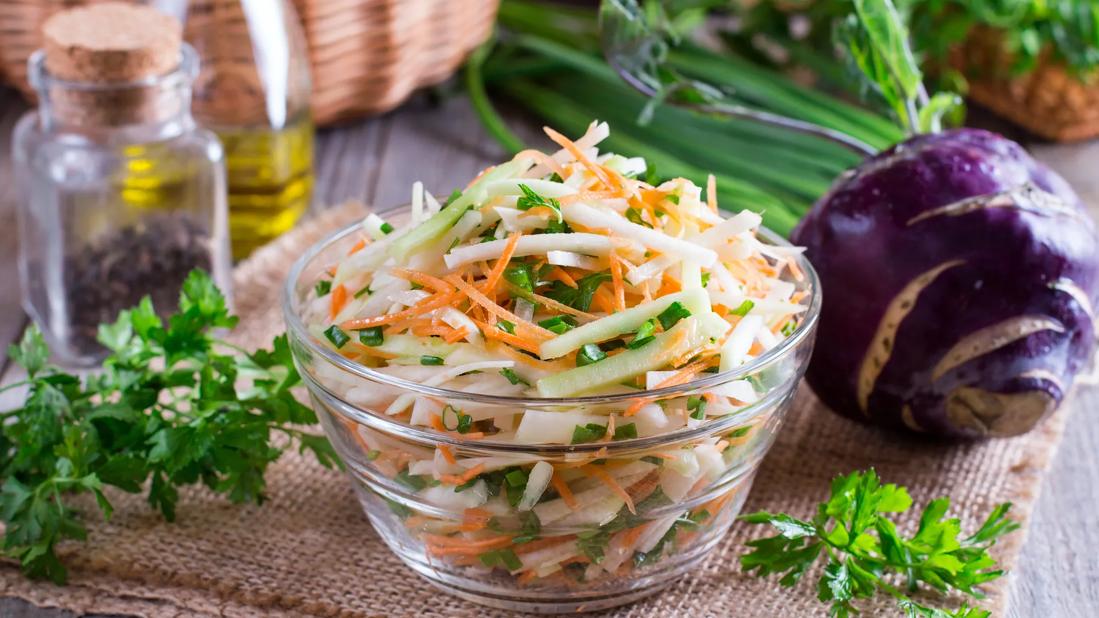High in antioxidants and vitamin C, kohlrabi lowers disease risk, protects your heart and aids digestion

With its bulbous globe and long, flowy stems, kohlrabi looks a bit like an alien spacecraft. But this slightly sweet, crunchy vegetable has more in common with cabbage than Martians.
Advertisement
Cleveland Clinic is a non-profit academic medical center. Advertising on our site helps support our mission. We do not endorse non-Cleveland Clinic products or services. Policy
“Kohlrabi is popular in Asia and Europe,” says registered dietitian Sereen Zawahri Krasuna, RD, LD. “It’s gaining more interest in North America as people become familiar with its delicious taste, nutritional benefits and versatile uses.”
Wondering what kohlrabi can do for your body? Zawahri Krasuna has the details.
Kohlrabi (pronounced “kole-RAH-bee”) is also called German turnip. It’s part of the Brassica oleracea family — a cruciferous vegetable, like cabbage and Brussels sprouts — and its leaves, stems and bulb can be eaten raw or cooked.
A layer of firm leaves encases kohlrabi’s bulb or globe. The leaves, stems and bulbs are usually green or purple, but there are white and red varieties, too. The inside of the bulb is always off-white.
“Kohlrabi is crunchy and has a mild sweetness, with a hint of pepper when it’s raw, similar to cabbage,” Zawahri Krasuna says. “When it’s cooked, though, it softens and becomes sweeter.”
Like other vegetables, kohlrabi is high in antioxidants and nutrients, which makes it a great addition to your diet. It’s also considered a low-histamine food, so it can be a healthy part of a low-histamine diet (though this should only be done under the care of a healthcare provider).
Advertisement
According to the U.S. Department of Agriculture (USDA), a cup of raw kohlrabi has approximately:
The same amount of kohlrabi provides these nutrients:
Here’s a look at some of the specific health benefits of kohlrabi.
A cup of raw kohlrabi provides nearly all of your recommended daily vitamin C.
“Vitamin C is a powerful antioxidant that helps boost your immune system and fight germs that cause illnesses,” Zawahri Krasuna shares. You also need vitamin C to help absorb iron and heal wounds.
Research suggests that polyphenols in the leaves of kohlrabi have both antioxidant and antibacterial benefits. Another study shows that glucosinolates — a type of phytonutrient found almost exclusively in cruciferous vegetables like kohlrabi — may help protect against some types of cancer.
Like most cruciferous vegetables, kohlrabi is good for your gut health. A cup of this veggie provides about 20% of your daily value — namely, insoluble fiber, which helps regulate your bowel movements and prevent constipation.
The fiber in kohlrabi also serves as a food source (prebiotic) for lactobacilli and bifidobacteria — intestinal bacteria are actually part of a healthy gut microbiome.
One study found that eating more kohlrabi and cruciferous vegetables lowered the risk of atherosclerosis and heart disease in participants over 70.
That makes sense because several of the nutrients in kohlrabi offer heart-protective benefits:
Yes, kohlrabi is an anti-inflammatory food because it has a lot of vitamin C and polyphenols, which are both powerful antioxidants. They help your body fight free radicals, unstable molecules that can damage your cells. When you don’t get enough antioxidants to balance free radicals, it can lead to oxidative stress.
“Cell damage and inflammation from oxidative stress increase your risk of chronic diseases like asthma, cancers, heart disease and Alzheimer’s disease,” Zawahri Krasuna warns.
Advertisement
Eating too many cruciferous vegetables, including kohlrabi, can cause uncomfortable bloating and farting.
“Complex fibers in cruciferous vegetables can be harder for you to digest,” Zawahri Krasuna explains. “They can ferment in your gut.”
Because glucosinolates (phytonutrients) in kohlrabi are sulfuric, you’re more likely to pass smelly gas.
There are a few other possible side effects of kohlrabi, too:
“Kohlrabi is a veggie, and like all veggies, it’s generally considered extremely healthy and very safe to add to your diet,” Zawahri Krasuna says. “But as with everything, moderation is key. If you’re not sure about incorporating it into your diet, check with a doctor or a dietitian to be sure.”
Advertisement
Ready to add kohlrabi to your next meal? There are lots of creative and tasty ways to do it. You can:
In conclusion, while kohlrabi might look a little strange, its benefits are anything but. Give it a try. Your body (and your taste buds!) will thank you.
Advertisement
Learn more about our editorial process.
Advertisement

Edamame, lentils and chicken breast are good sources of protein

Too much sodium can cause high blood pressure and increase your risk of heart disease

Eating too much salt can put extra pressure on your blood vessels and heart

The gluten-free, fiber-rich superfood supports gut and heart health and can help with diabetes management

Wasabi root may protect against cancer, food poisoning and memory loss

Limes and lime juice are rich in vitamins, minerals, antioxidants and other nutrients

This herbal drink may ease allergies and boost prostate health

The common flavor enhancer has had a bad reputation — but here’s what the research shows

The best parenting style balances enforcing rules and showing plenty of love

Tips include cutting back on sugar, focusing on exercise and managing stress

It can be harder to let go when you’ve invested time, energy and emotions — but it might be the healthier choice long term